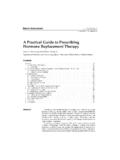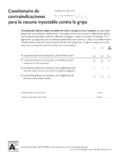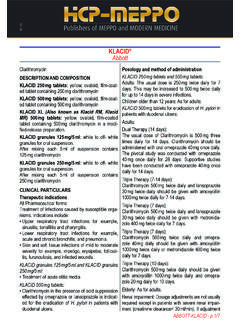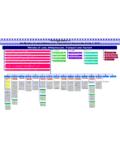Transcription of Human Factors Aspects of Using Head Up Displays …
1 Departmentof TransportationNational HighwayTraffic SafetyAdministratlonDOT HS 808 320 Interim ReportAugust 1995 Human Factors Aspects of UsingHead Up Displays in Automobiles:A Review of the LiteratureThis document IS available to the public from the Natlonal Technical lnformatlon Service, Springfield, Virginia publication is distributed by the Department ofTransportation, National Highway Traffic Safety adminis -tration, in the interest of information exchange. The opinions,findings and conclusions expressed in this publication are thoseof the author(s) and not necessarily those of the Departmentof Transportation or the National Highway Traffic SafetyAdministration.
2 The United States Government assumes noliability for its contents or use thereof. If trade or manufac-turers name or products are mentioned, it is because they areconsidered essential to the object of the publication and shouldnot be construed as an endorsement. The United StatesGovernment does not endorse products or Report Documentation Page 1. Report HS 808 320 IIIIIV~I I. 2. Government Accession No.
3 3. Recipient s Catalog Titleand SubtitleHuman Factors Aspects of Using Head UP Displays5. Report DateAugust 1995in Automobiles: A Review of the Literature-7. Author(s)Kenneth W. Gish and Loren Staplin9. Performing Organization Name and AddressThe Scientex CorporationHuman Factors Division1250 South Broad Street, Suite 3000 Lansdale, PA 1944612. Sponsoring Agency Name and AddressOffice of Crash Avoidance ResearchNational Highway Traffic Safety Department of TransportationWashington, DC 2059015. Supplementary Notes6.
4 Performing Organization Code1454-026. Performing Organization Report Work Unit No. (TRAIS)11. Contract or Grant AGI 1684--0113. Type of Report and Period CoveredInterim14. Sponsoring Agency CodeNHTSA COTR, Mr. Michael Perel, NRD-52. This report was prepared under a cooperative agreementbetween NHTSA and the National Institutes of Health (National Institute on Aging) through the Edward Center for Enhancement of Mobility for the Elderly at Western Kentucky AbstractThis document provides an overview of studies investigating the use of HUDs by aviators anddrivers, including a summary of HUD research variables, test procedures and study results.
5 Thepredicted performance advantages of automotive HUDs include increased eyes-on-the-road time andreduced reaccommodation time, particularly for the older driver. To date, the research does notprovide robust evidence for operationally significant performance advantages due to , conclusions are equivocal due to the interaction of independent variables such asworkload, display complexity and age. Studies indicate that key operator performance issues withHUDs include contrast interference, where HUD symbology masks safety-critical targets in theforward driving scene, and cognitive capture, or degradation of responses to external targets dueto the processing of information from a HUD image.
6 In general, the review supports and extendsearlier findings that HUD information cannot be processed separately from external roadwayinformation. Countermeasures reviewed in this paper include the use of conformal symbology, andauditory HUDs. The review identifies a number of implementation issues for automotive HUDs: (1)reliable measures of the effect of HUD use on responses to priority external targets must beobtained, under realistic operating conditions; (2) practical considerations of cost, size, andadaptability to a range of driver eye heights figure prominently if the use of HUDs in the privatevehicle fleet in the is to become routine.
7 And (3) driver age and associated visual/cognitiveperformance differences which are commonly linked to safe vehicle operation must be taken intoaccount during product design, development, and Key Words 16. Dirtribution StatementHead-up Displays Conformal symbology Response time This document is available to the publicAccommodation Contrast interference Visibility through the National Technical InformationCognitive capture Refixation time Driver age Service, Springfield, Virginia 2216119.
8 Security Classif. (of this report) 20. Security Clessif. (of this page) 21. No. of Pages 22. PriceUnclassified UnclassifiedForm DOT F (B-72)Reproduction of completed page authorizediTable of ContentsGlossary .. v Executive Summary .. , .. , .. , .. xiIntroduction .. 1 Aviation Versus Automotive 1 Information content of external 1 Visual clutter 2 Age 2 Workload and task 3 Standardization and training 3 Expected Performance Advantages of Automotive 4 Increased eyes-on-the-road 4 Reduced reaccommodation 5 Considerations for older 6 Current HUD Design 7 Display 7 Design of display 7 Field-of-view limitations.
9 8 Display luminance contrast .. 8 Operator Performance 10 Contrast interference and visual 10 Virtual image 13 Misaccommodation/misconvergence 14 Binocular 15 Luminance contrast 15 HUD contrast and cognitive 16 Spatial 17 Cognitive capture and 18 Attention, mental workload, and cognitive 22 Effect of HUDs on Driving Speed .. , .. 27 Implementation Issues for Automotive HUDs.
10 28 Summary and Critique of Current Findings and for performance 31 Critique of laboratory studies Using experimental-use-only Issues in Future HUD 34 Signal detection analysis and forced-choice 36 Assessing dual-task resource allocation .. 36 Objective measures of gaze 37 Bibliography .. A: Summary Table of HUD Research 47 Appendix B: Current and Proposed Automotive HUD Designs .. 73 iiiGlossaryThe following terms are used throughout this literature definitions reflect commonusage where some instances, distinctions are made between terms that are not typically madein the literature (for example, between attentional tunneling and cognitive capture).







